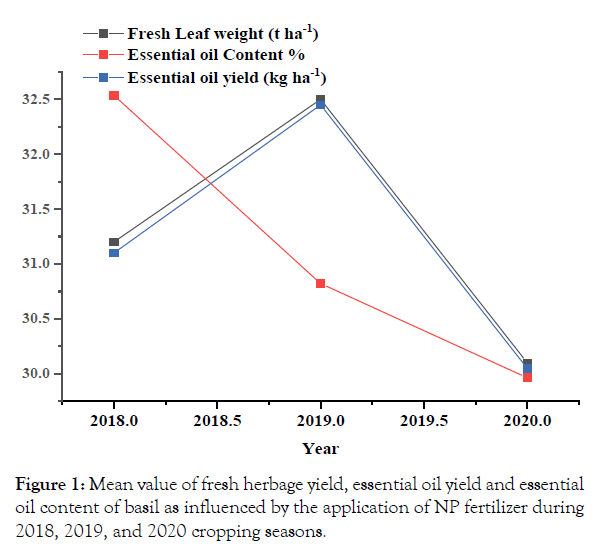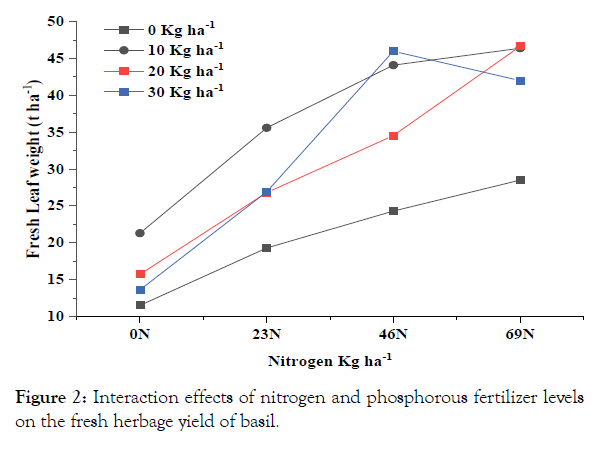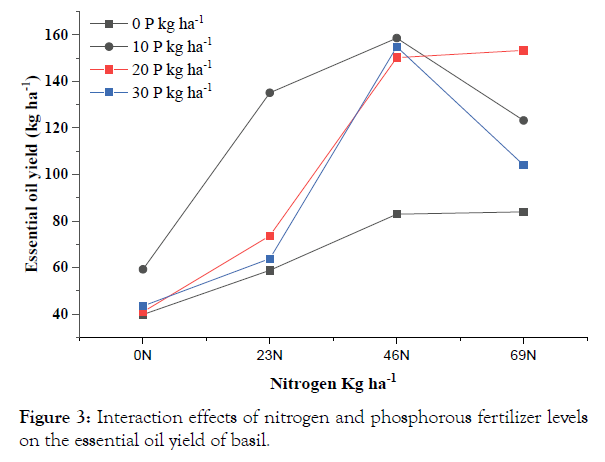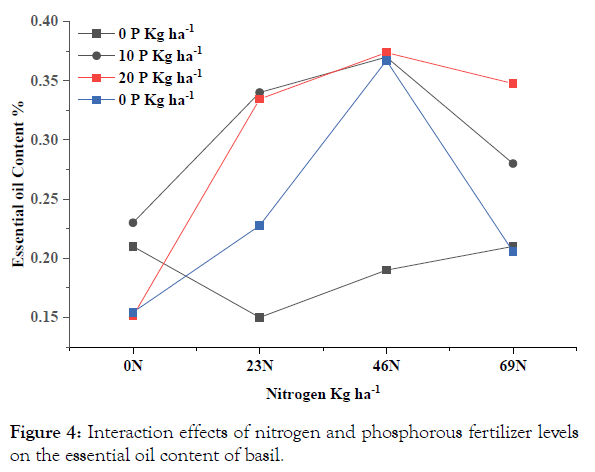Medicinal & Aromatic Plants
Open Access
ISSN: 2167-0412
ISSN: 2167-0412
Research Article - (2021)Volume 10, Issue 6
Nitrogen and Phosphorous were believed to be important nutrient for the production of sweet basil (Ocimum basilicum L.) with desirable essential oil yield, essential oil content and acceptable herbage yields. The experiment was carried out for three (2018-2020) consecutive seasons, at Wondo gent agricultural research center. This study was conducted to determine the effects of nitrogen and phosphorus fertilizer on essential oil yield, essential oil content, and herbage yields of sweet basil (Ocimum basilicum L.). The treatments were using N (0, 23, 46, and 69 kg ha-1) and P (0, 10, 20, and 30 kg ha-1) in Randomized Complete Block Design (RCBD) a factorial with three replications. The results indicated that the maximum essential oil yield (202.7 kg ha-1), essential oil content (0.53%), and herbage yields (47.0 tone ha-1) were obtained from application of 69 kg ha-1 of N and 20 kg ha-1 P fertilizers. However, the minimum essential oil yield, essential oil content, and herbage yields were obtained from unfertilized plot. Therefore, the application of 69 kg ha-1 of nitrogen and 20 kg ha-1 phosphorous fertilizers was suggested in Wondo gent, Ethiopia to obtain the ideal fresh herbage yields and essential oil yield of sweet basil (Ocimum basilicum L.).
Essential oils; Herbage yields; Nitrogen; Phosphorous; Sweat basil
Sweet basil (Ocimum basilicum L.) is a well-known and appreciated spice and medicinal plant [1]. It is one of the popular aromatic and/essential oil-bearing, and medicinal herbs and cultivated and native to many countries all over the world Africa; Ethiopia, India, and Asia and cultivated in temperate climates [1]. Sweet basil is used in traditional medicines, in the cosmetic industry, as a culinary herb, and as an insect repellent [2]. The high economic value of basil oil is due to the presence of phenylpropanoids like eugenol and chavicol and due to terpenoids like monoterpenes alcohol linalool and methyl cinnamate.
Ethiopia has exported 68,786 kg of basil essential oil to Sudan and the USA, from which a total foreign currency of $54,991.20 and $746.00, respectively, was obtained back in 2009. The export volume accounted for 19.8% between 2006 and 2009 and exhibited 0.15 and 0.14% both volume and share value of the total spice export [3]. This figure indicates that the productivity of basil is much below its potential. Nevertheless, the quality of essential oil is dependent on the relative composition of the oil constituents, which is greatly influenced by the agro-climatic condition as well as nutrient management [4]. For the virtuous development of any crop, it is very important to have fertile soil, water, and sunlight as well as good agronomical management. Biesiada and Kus [5] verified that a straight relation on the growth of basil and macro elements accumulation with irrigation and nitrogen and phosphorus rate doses.
Plant nutrition is one of the most important factors that increase plant production. Nitrogen (N) and phosphorous (P) play key roles in plant metabolism and have effects on the synthesis and accumulation of nutrients and secondary metabolites. Nitrogen is an important yield-enhancing primary nutrient and is necessary for building amino acids, structural elements of proteins as well as pyrimidine and purine bases, nucleotides, and nucleic acids. According to Baranauskienne [6] were found that N fertilizer increased herb yield. Similarly Arabaci and Bayram [7] found that N fertilizer increased the amount of green herb yield, drug-herb yield, drug leaves, essential oil (% and yield) of basil (Ocimum basilicum L.). Nitrogen fertilization increased the dry weight of Mentha. × Piperita, linalool chemotype [8].
Phosphorus also plays an important role in numerous metabolic processes. It activates coenzymes for amino acid production and used in protein synthesis. P also aids in flower initiation, seed, and fruit development in root development, flower initiation, seed and fruit development, and significantly more leaf biomass [9]. The application of phosphorus increased the essential oil content and fresh herbage yield in basil and different mint species [10]. The phosphorous had a stimulating effect on the growth parameters, total carbohydrates, soluble sugars, mineral contents and on the percentage of essential oil production from chamomile flowers compared with the control [11]. Similarly, Rao [12] verified that the application of nitrogen and phosphorous has resulted in higher plant yield and essential oil content. In this regard, environmental factors and agricultural practices are as much important as the genetic factors that affect the composition and activity of basil essential oils [13]. Therefore, nitrogen and phosphorous fertilization are essential for crop production; its importance on the plant’s physiology, oil gland morphology, essential oil content, and composition is not satisfactory studied especially in Ethiopian conditions. Therefore, in this study, we investigate the possible effect of nitrogen and phosphorus fertilizer on the fresh herbage yield and essential oil yield and to determine the optimum rate of nitrogen and phosphorus fertilizers for basil (Ocimum basilicum L.) Wondo Gent, Ethiopia.
Description of experimental sites
The study was conducted at Wondo Genet agricultural research center for three (2018-2020) consecutive growing sessions. The geographical coordination of the study area is 7°19’.31” N latitude and 38°38’.55” E longitude with an altitude of 1780 meters above sea level. The site receives a mean annual rainfall of 1128 mm with minimum and maximum temperatures of 11°C and 26°C, respectively.
Experimental design and treatments
The field experiment was carried out under irrigated conditions and established in a randomized complete block design (RCBD) in factorial arrangement with three replications. The experiment was consisting 16 total treatments with a combination of four levels of Nitrogen (0, 23, 46, and 69) and four Phosphorous (0, 10, 20, and 30). The improved variety of sweat basil was used and planted in a row by 60 cm inter-row spacing and 60 cm intra-row spacing. Single fertilizers of N containing Urea and P containing Triple Superphosphate (TSP) were used for the experiment. Phosphorus fertilizer was basally applied once at planting time. However, nitrogen fertilizer was applied in a split form (1/2 at planting and the remaining 1/2 at the beginning of maximum growing stage) which is to minimize the losses N and increase nutrient use efficiency. All other management practices were carried out uniformly to all experimental units throughout the growing season.
Crop harvest, soil sampling, essential oil yield, and analyses
At maturity, 2 m2 of basil was manually harvested from the middle of each plot to determine the flesh leaf, essential oil content, and essential oil yield. Composite soil samples were sampled at random across all experimental at a depth of 0-20 cm before treatment application using an auger. The soil samples were air-dried, were processed, and analyzed for soil texture, pH, organic carbon, total nitrogen, available phosphorous, total sulfur, and cation exchange capacity, and were analyzed following the standard procedures outlines. Essential oil content essential oil yield was determined using gas chromatography-mass spectrophotometer apparatus at Wondo genet agricultural research center natural products laboratory.
Statistical analysis
The data was analyzed by using a two-way analysis of variance (ANOVA) using statistical analysis software (SAS) version 9.4 [14]. Whenever the treatment effects were significant, mean separations were made using the Least Significant Difference (LSD) test at (p ≤ 0.05) level of probability test by proc-mixed analysis.
Physico-chemical properties of experimental site soil
The results of the physicochemical properties of the composite surface soil (0-20 cm) collected before planting showed that the textural class of the soil is loam with slightly acidic (pH 6.5) indicating that these properties are favorable for major crop production [15] (Table 1). The total nitrogen (%) and organic carbon content (%) of experimental site soil was (0.25%) and (2.6%) respectively. According to Tekalign Tadese [16] rating of the experimental soil of total nitrogen high and organic carbon content moderate. Available phosphorous and CEC of experimental soil was 12.7 mg kg-1 and 35.1 Cmol+ kg-1 which is medium and high according to Cottenie, Hazelton, and Murphy [17,18] respectively.
| Properties | Values |
|---|---|
| Sand | 42% |
| Silt | 43% |
| Clay | 15% |
| Texture Class | loam |
| pH | 6.5 |
| Total N | 0.26% |
| Available P | 12.7 mg kg-1 |
| Organic Carbon | 2.8% |
| CEC | 35.1 Cmol+ kg-1 |
Table 1: Soil physico-chemical properties.
Interaction effects of nitrogen and phosphorus on basil fresh leaf weight
The responses of fresh herbage yield, essential oil yield, and essential oil content of basil to the rates of NP fertilizer application and their interaction was computed using data combined over three cropping seasons and highly significant (p<0.01). There is no interaction of fertilizer over year. The analysis result indicated that a pooled mean value fresh herbage yield, essential oil yield, and essential oil content of basil ranged from 30.1- 32.5 tone ha-1, 105-112.2 kg ha-1, 0.28-0.31% respectively (Figure 1).

Figure 1: Mean value of fresh herbage yield, essential oil yield and essential oil content of basil as influenced by the application of NP fertilizer during 2018, 2019, and 2020 cropping seasons.
The statistical analysis revealed that combined application of nitrogen and phosphorous fertilizer can significantly highly (p<0.01) influence the fresh herbage yield of basil during all growing seasons (Figures 2-4). However, there was no significant variation in basil fresh leaf main effect. The maximum fresh leaf value (47.0 tone ha-1) was obtained from the application of 69 kg ha-1 nitrogen with 20 kg ha-1 phosphorous fertilizers. However, the minimum fresh leaf of basil (11.5 tone ha-1) was obtained from a control or unfertilized plot. This is because nitrogen (N) and phosphorous (P) play key roles in plant metabolism and have effects on the synthesis and accumulation of nutrients and secondary metabolites. Nitrogen is an important yield-enhancing primary nutrient and is necessary for building amino acids, structural elements of proteins as well as pyrimidine and purine bases, nucleotides, and nucleic acids. Stewart and Lovett-Doust [9] were stated that application phosphorous fertilizer is also aided significantly more leaf biomass development. This result was agreed with Ramezani [10] were found that application of phosphorus increased the essential oil content and fresh herbage yield in basil and different mint species. Similarly, Baranauskienne [6] were found that N fertilizer increased the herb yield of aromatic plants. Application of nitrogen fertilizer can increase the amount of green herb yield, drug-herb yield, drug leaves, essential oil (%) and essential oil yield on sweet basil (Ocimum basilicum L.) [7].

Figure 2: Interaction effects of nitrogen and phosphorous fertilizer levels on the fresh herbage yield of basil.

Figure 3: Interaction effects of nitrogen and phosphorous fertilizer levels on the essential oil yield of basil.

Figure 4: Interaction effects of nitrogen and phosphorous fertilizer levels on the essential oil content of basil.
Interaction effects of nitrogen and phosphorus on essential oil yield and oil contents of basil
Oil production is the most important and economic part of basil. The essentials oil yield of basil significantly influenced due to the application of different levels of nitrogen and phosphorous fertilizers application. It is marked from (Figures 2-4) that the application of 69 kg ha-1 of nitrogen and 20 kg ha-1 phosphorous recorded significantly the highest essentials oil yield (202.7 kg ha-1) and essential oil content (0.53%) of basil. Nevertheless, the minimum essentials oil yield (39.8 kg ha-1) and essentials oil content (0. 21%) were obtained from unfertilized plots. This is because of positive interaction effects of NP and may be due to the important physiological role of the nutrient in the crop. Nitrogen is playing an important role in the synthesis of the plant constituents through the action of different enzymes activity and protein synthesis [19]; that is also reflected on an increase in growth parameters and chemical constituents of most aromatic and medicinal herbs. Phosphorous had a stimulating effect on the growth parameters, total carbohydrates, soluble sugars, mineral contents, and on the percentage of essential oil production from chamomile compared with the control [11]. Similarly, Arabaci and Bayram [7] found that N fertilizer increased the amount of green herb yield, drug- herb yield, drug leaves, essential oil (% & yield) of basil (Ocimum basilicum L.). These results are similar to the observation of different scholars (Sharafzadeh, [20] and Jeliazkova [21] were found that increase the NP fertilizer rates caused a significant increase in the vegetative growth, essential oil (%) and essential oil yield of some aromatic and medicinal herbs such as sweet basil (Ocimum basilicum L.), different mint species (Mentha × Piperita L.), thyme (Thymus Vulgaris L.) and chamomile.
In the study, combined application of nitrogen and phosphorus fertilizer was significantly increase herbage yields and essential oil yield as well as oil content of sweet basil (Ocimum basilicum L.). The maximum essential oil yield (202.7 kg ha-1), essential oil content (0.53%), and herbage yields (47.0 tone ha-1) were obtained from application 69 kg ha-1 of N and 20 kg ha-1 P fertilizers. Thus, the application of 69 kg ha-1 of nitrogen and 20 kg ha-1 phosphorous fertilizers was suggested in Wondo gent, Ethiopia to obtain the ideal herbage yields and essential oil yield of sweet basil (Ocimum basilicum L.).
The authors have not declared any conflict of interests.
The authors thankful to the Ethiopian Institute of Agricultural Research (EIAR) for funding field and laboratory works. We would also like to appreciate the technical and the natural product laboratory staff of the Wondo Genet research center for their assistance in managing the field work activities.
Citation: Hordofa Sigaye M, Lulie B, Yakob A, Nigussei A, Mekuria R, Kebede K (2021) Fresh Herbage and Essential Oil Yield of Sweet Basil (Ocimum basilicum L.) as Affected by Mineral Fertilizers. Med Aromat Plants (Los Angeles) 10: 389.
Received: 27-May-2021 Accepted: 07-Jun-2021 Published: 14-Jun-2021 , DOI: 10.35248/2167-0412.21.10.389
Copyright: © 2021 Sigaye MH, et al. This is an open-access article distributed under the terms of the Creative Commons Attribution License, which permits unrestricted use, distribution, and reproduction in any medium, provided the original author and source are credited.